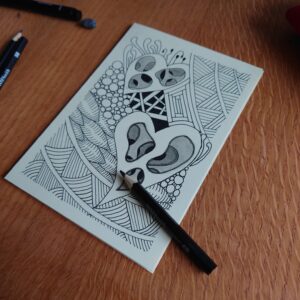It’s a feeling that may sound familiar: being stuck on a thought like a dog with a bone. It wasn’t until my late autism diagnosis that I finally found the language for it: autistic rumination. In that name, there was understanding, and in that understanding, a strange sort of solace.
For as long as I can remember, I have been a worrier. I have a distinct memory of walking into town with my mum when I was about nine or ten and feeling a wave of genuine panic about mortgages. I had no real concept of what they were, but the idea of them—this huge, adult responsibility—was enough to send my brain into a spin.
That spinning sensation never really stopped; it simply changed its focus over the years. It attached itself to things from the past that I wished I could change; things that were happening that I couldn’t stop; and, of course, the endless catalogue of things that hadn’t happened but might.
The Rumination Loop: A Feature, Not a Bug?
Before my diagnosis, I simply considered myself a champion overthinker. My mum mentioned during my assessment how I’d always weigh up every single possibility before taking the smallest risk. In some ways, this ability to deep-dive into a topic—to analyse it from every conceivable angle—can feel like a superpower. It’s the same wiring that fuels our hyperfocus, allowing us to see patterns and details that others might miss; monotropic thinking, and advanced analytical thinking. It is, undoubtedly, a useful skill.
However, this trait is a double-edged sword. When that intense focus latches onto a worry, a social misstep, or an injustice, it often doesn’t let go. The analysis turns into obsession and the problem-solving becomes a loop of what-ifs and if-onlys. It’s utterly, bone-deeply draining and has been the source of some of my greatest anxiety and lowest moods. I often think back on all the precious time and energy poured into worrying.
It’s not something I’ve managed to ‘get rid of’, and I’ve come to realise that may not be the goal. While part of me wishes I could just switch it off, I feel it’s part of my wiring—this tendency to get stuck.

Finding the Off-Ramp: How to Escape the Thought Loop
Discovering that I wasn’t alone in this was transformative. Listening to other autistic adults talk about their own rumination loops made me feel seen. It is a shared experience, and in that shared knowledge, we can find shared solutions.
While I haven’t found a cure, I have found respite. For me, the most effective antidote to being stuck in my head is to become completely absorbed in my hands—finding an ‘off-ramp’ from the mental motorway.
- Creative Flow States: This has been my primary escape route. When I’m drawing, my mind is focused only on the line, the shadow, and the colour. When I’m crocheting, I’m not replaying a conversation from last Tuesday; I’m thinking about yarn tension, hook size, and the quiet rhythm of ‘yarn over, pull through’. It’s a form of active mindfulness that doesn’t ask me to empty my mind, but rather to fill it with something else entirely—something tactile and soothing.
- Healthy Escapism: Video games have served a similar purpose. A good game demands your full attention as you problem-solve, explore a new world, or follow a story. There’s simply no room left for the worry to take up residence. It’s a temporary, but welcome, eviction.
- Gentle Mindfulness: While traditional meditation doesn’t always click with me, the core principle of mindfulness—noticing your thoughts without judgement—can be powerful. Simply naming the experience, “This is rumination,” can sometimes be enough to create distance from it.

These are my strategies. They might not be yours, and that’s okay. The goal isn’t to find a magic bullet but to build a personal toolbox of off-ramps. For you, it might be building a complex Lego set, doing a difficult puzzle, listening to a dense history podcast, or going for a walk and focusing only on the sounds of the birds.
Ultimately, it’s not about fighting your brain. It’s about understanding its tendencies and lovingly giving it a different, more wonderful bone to chew on.

Leave a Reply